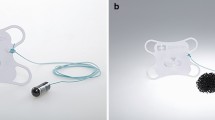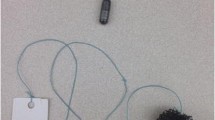Abstract
Introduction
Sponge cytology is a novel screening tool for esophageal cancer but has been unable to be validated for widespread use. Our aim was to apply fluorescent in situ hybridization to sponge cytology samples in order to evaluate the safety and efficacy of this modality in screening for esophageal cancer.
Materials and Methods
At a single, multidisciplinary, NCI-designated cancer center, patients completed sponge cytology sampling prior to upper endoscopy. Samples were analyzed by p53 fluorescent in situ hybridization, and results were compared to the endoscopic diagnosis.
Results
Fifty patients were enrolled (96 % Caucasian, 68 % male, median age of 67). All patients successfully swallowed the capsule. No complications (string breakage, bleeding, mucosal injury) occurred. Endoscopy revealed that 38 % had normal esophageal mucosa and 62 % had an esophageal mucosal abnormality. In total, six samples demonstrated p53 loss (94 % specificity for any abnormality). The sensitivity of the p53 fluorescent in situ hybridization probe was13.3 % for any abnormality, 10 % for intestinal metaplasia, and 0 % for dysplasia or esophageal cancer.
Discussion
Esophageal sponge cytology is a promising, safe, and tolerable method for collecting esophageal cell samples. However, our data suggest that p53 fluorescent in situ hybridization does not improve the sensitivity for detecting cancer in these samples.


Similar content being viewed by others
References
National Cancer Institute. SEER Cancer statistics Factsheets: Esophageal Cancer. http://seer.cancer.gov/statfacts/html/esoph.html. Last accessed: 5/02/2015.
Kamangar F, Dores G M, Anderson W F. Patterns of cancer incidence, mortality, and prevalence across five continents: defining priorities to reduce cancer disparities in different geographic regions of the world. J Clin Oncol 2006; 24: 2137–2150.
Ajani JA, D’Amico TA, Almhanna K, Bentrem DJ, Besh S, Chao J, Das P, Denlinger C, Fanta P, Fuchs CS, Gerdes H, Glasgow RE, Hayman JA, Hochwald S, Hofstetter WL, Ilson DH, Jaroszewski D, Jasperson K, Keswani RN, Kleinberg LR, Korn WM, Leong S, Lockhart AC, Mulcahy MF, Orringer MB, Posey JA, Poultsides GA, Sasson AR, Scott WJ, Strong VE, Varghese TK Jr, Washington MK, Willett CG, Wright CD, Zelman D, McMillian N, Sundar H; National comprehensive cancer network. Esophageal and esophagogastric junction cancers, version 1.2015. J Natl Compr Canc Netw. 2015;13(2):194–227.
van Hagen P, Hulshof M C, van Lanschot J J et al. Preoperative chemoradiotherapy for esophageal or junctional cancer. N Engl J Med 2012; 366: 2074–2084.
National Comprehensive Cancer Network, Inc. 2012 NCCN Clinical Practice Guidelines in Oncology, Esophageal and Esophagogastric Junction Cancers.
Booth CL, Kevin S. Thompson. Barrett’s esophagus: A review of diagnostic criteria, clinical surveillance practices and new developments. J Gastrointest Oncol 2012;3(3):232–242.
Gerson LB, Triadafilopoulos G. Screening for Esophageal Adenocarcinoma: An Evidence-Based Approach. Am J Med. 2002;113:499–505.
Lagergren J, Bergstrom R, Lindgren A, Nyren O. Symptomatic gastroesophageal reflux as a risk factor for esophageal adenocarcinoma. New England Journal of Medicine. 1999b;340:825–31.
Dawsey SM, Q Shen, R K Nieberg, et al. Studies of esophageal balloon cytology in Linxian, China. Cancer Epidemiol Biomarkers Prev 1997; 6:121–130.
Wang LD, Huai Hua Yang, Zong Min Fan, Xiao Dong Lu, Jun Kuan Wang, Xiao Li Liu, Zhe Sun, Ya Nan Jiang, Xin He, Qi Zhou. Cytological screening and 15 years’ follow-up (1986–2001) for early esophageal squamous cell carcinoma and precancerous lesions in a high-risk population in Anyang County, Henan Province, Northern China. Cancer Detection and Prevention. 29 (2005) 317–322.
Muriithi RW, Muchiri LW, Lule GN. Esophageal cytology sponge diagnostic test results in kenyatta national referral hospital, kenya. Acta Cytol. 2014;58(5):483–8.
Roshandel G, Merat S, Sotoudeh M, Khoshnia M, Poustchi H, Lao-Sirieix P, Malhotra S, O’Donovan M, Etemadi A, Nickmanesh A, Pourshams A, Norouzi A, Debiram I, Semnani S, Abnet CC, Dawsey SM, Fitzgerald RC, Malekzadeh R. Pilot study of cytological testing for oesophageal squamous cell dysplasia in a high-risk area in Northern Iran. Br J Cancer. 2014;111(12):2235–41.
Kadri SR, Lao-Sirieix P, O’Donovan M, Debiram I, Das M, Blazeby JM, Emery J, Boussioutas A, Morris H, Walter FM, Pharoah P, Hardwick RH, Fitzgerald RC. Acceptability and accuracy of a non-endoscopic screening test for Barrett’s oesophagus in primary care: cohort study. BMJ. 2010;341:c4372.
Pan QJ, Roth MJ, Guo HQ, Kochman ML, Wang GQ, Henry M, Wei WQ,.Giffen CA, Lu N, Abnet CC, Hao CQ, Taylor PR, Qiao YL, Dawsey SM. Cytologic Detection of Esophageal Squamous Cell Carcinoma and Its Precursor Lesions Using Balloon Samplers and Liquid-Based Cytology in Asymptomatic Adults in Linxian, China. Acta Cytol 2008;52:14–23.
Ross-Innes CS, Debiram-Beecham I, O’Donovan M, Walker E, Varghese S, Lao-Sirieix P, Lovat L, Griffin M, Ragunath K, Haidry R, Sami SS, Kaye P, Novelli M, Disep B, Ostler R, Aigret B, North BV, Bhandari P, Haycock A, Morris D, Attwood S, Dhar A, Rees C, Rutter MD, Sasieni PD, Fitzgerald RC; BEST2 Study Group. Evaluation of a minimally invasive cell sampling device coupled with assessment of trefoil factor 3 expression for diagnosing Barrett’s esophagus: a multi-center case–control study. PLoS Med. 2015;12(1).
Bansal A, Fitzgerald RC. Biomarkers in Barrett’s Esophagus: Role in Diagnosis, Risk Stratification, and Prediction of Response to Therapy. Gastroenterol Clin North Am. 2015;44(2):373–90.
International Cancer Genome Consortium (ICGC). https://icgc.org/. Last accessed: March 2016.
Ross-Innes CS, Becq J, Warren A, Cheetham RK, Northen H, O’Donovan M, Malhotra S, di Pietro M, Ivakhno S, He M, Weaver JM, Lynch AG, Kingsbury Z, Ross M, Humphray S, Bentley D, Fitzgerald RC. Oesophageal Cancer Clinical and Molecular Stratification (OCCAMS) Study Group. Whole-genome sequencing provides new insights into the clonal architecture of Barrett’s esophagus and esophageal adenocarcinoma. Nat Genet. 2015;47(9):1038–46.
Salomao M, Gonda TA, Margolskee E, Eguia V, Remotti H, Poneros JM, Sethi A, Saqi A. Strategies for improving diagnostic accuracy of biliary strictures. Cancer Cytopathol. 2015. 123(4); 244–52.
Zhai J. Multitarget fluorescence in situ hybridization assay for the detection of lung cancer in bronchial cytology specimens: A Comparison With Routine Cytology. Diagn Cytopathol. 2015;43(10):819–24
Schmitt F, Barroca H. Role of ancillary studies in fine-needle aspiration from selected tumors.[Review] Cancer Cytopathology. 120(3):145–160, 2012.
Fahmy M et al. Chromosomal gains and genomic loss of p53 and p16 genes in Barrett’s esophagus detected by fluorescence in situ hybridization of cytology specimens. Modern Pathology. 2004;17:588–596
Wu TT, Rezai B, Rashid A, Luce MC, Cayouette MC, Kim C, Sani N, Mishra L, Moskaluk CA, Yardley JH, Hamilton SR. Genetic alterations and epithelial dysplasia in juvenile polyposis syndrome and sporadic juvenile polyps. Am J Pathol. 1997;150(3):939–47
Fitzgerald RC. Combining simple patient-oriented tests with state-of-the-art molecular diagnostics for early diagnosis of cancer. United European Gastroenterol J. 2015;3(3):226–9.
Kaz AM, Grady WM. Epigenetic biomarkers in esophageal cancer. Cancer Left. 342 (2) 193–200. 2012.
Kandioler D, Schoppmann SF, Zwrtek R, Kappel S, Wolf B, Mittlböck M, Kührer I, Hejna M, Pluschnig U, Ba-Ssalamah A, Wrba F, Zacherl J. The biomarker TP53 divides patients with neoadjuvantly treated esophageal cancer into 2 subgroups with markedly different outcomes. A p53 Research Group study. J Thorac Cardiovasc Surg. 148(5); 2280–6. 2014.
Acknowledgments
We would like to acknowledge the contributions of Charlie Borzy, the study coordinator who maintains our data and was instrumental in study design and IRB approval. We additionally thank Mary Kwatkosky-Lawlor for her assistance with the manuscript editing and formatting.
Authorship
All authors listed above have contributed substantially to the design and acquisition of the data in this study as well as drafting of and final approval of this manuscript.
Author information
Authors and Affiliations
Corresponding author
Ethics declarations
Conflict of Interest
The authors declare that they have no conflict of interest.
Funding Sources
This study was funded by the Newton Foundation Grant.
Additional information
Meeting Presentation
Digestive Diseases Week, May 21–24, 2016. San Diego, CA (Poster)
Rights and permissions
About this article
Cite this article
Haisley, K.R., Dolan, J.P., Olson, S.B. et al. Sponge Sampling with Fluorescent In Situ Hybridization as a Screening Tool for the Early Detection of Esophageal Cancer. J Gastrointest Surg 21, 215–221 (2017). https://doi.org/10.1007/s11605-016-3239-3
Received:
Accepted:
Published:
Issue Date:
DOI: https://doi.org/10.1007/s11605-016-3239-3




